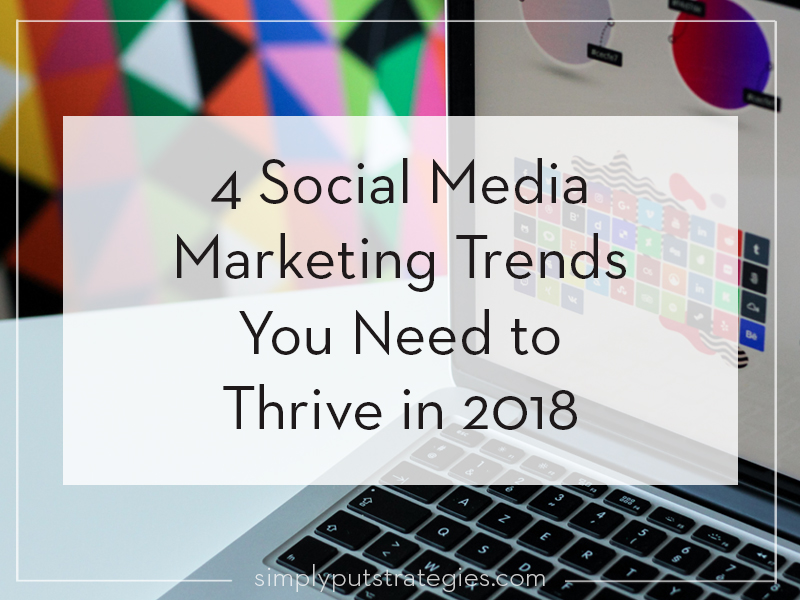Another year, another cluster of social media trends to wrap your mind and marketing strategy around. December can be overwhelming for a host of reasons, not the least of which is planning your business and marketing strategy for the coming year!
Social media networks, and the algorithms that run them, change so often it probably makes your head spin. Staying up-to-date on the latest social media marketing trends is a big task, especially when you’re also running your business, serving your clients, and networking in your community. That’s what social media marketers like me are here for; our job is to stay on top of this stuff so that you don’t have to! Without further ado, I bring you the top social media marketing trends you should consider implementing in 2018.
Social Marketing Trend 1: Organic reach is STILL declining 📉
Now is a great time to strengthen strategies that do not rely on organic placement in Facebook’s News Feed, or any other social newsfeed. Instead, consider:
- Improving your relationships with micro-influencers
- Revisiting “old fashioned” marketing tactics (blog post forthcoming)
- Improving your capture systems for new leads and maintaining your relationship with old ones
- Dialing up your Pinterest game (blog post forthcoming)
- Experimenting with Stories. Stories (available on Instagram and Facebook and originating on Snapchat) are a great way to be casual, spontaneous and genuine with your audience.
I’ll go into more detail on these in future blog posts and later in this one. It’s important to start with this trend because it’s a reality that many social media marketers and businesspeople grumble about facing.
The truth is, we’ve been spoiled: the heyday of organic reach felt like “free” advertising (though it wasn’t truly free. It takes time and/or money to create content!) and it set up false expectations. Think about it: since when has advertising been free? And why would it be? Billboards, print ads, bus stop ads, taxi-cab ads… all pre-digital marketing options had a cost. It’s time we stop expecting social media marketing to be any different.
Social Marketing Trend 2: Video. Video video video video 📹
Video is huge – so huge that my colleague Katie Goudie published an entire blog post on why you need to use video marketing in 2018 (featuring a quote from yours truly!). In particular, video consumption on mobile is on the rise. This year is a great time to try:
- Short, 5-15 second “snackable” videos that feel good and are designed for sound off (Note: Instagram video limit is 15 seconds!).
- Sound off? Videos on social are set to begin playing with sound off, meaning they start playing silently as soon as they scroll into view. A user must engage with the video to get sound. Make sure that when your video starts playing, it’s designed for sound off! That could mean starting the video with text slides or adding captions.
- Square videos instead of landscape. Square videos take up 78% more real estate in mobile Facebook News Feed and have a 67% higher completion rate!
- Storytelling videos that aren’t too polished or rehearsed. Consumer trust is declining, so the more you seem like a person and less like a brand, the easier it is for your audience to connect with you.
- Facebook Live: you’ve probably heard that Facebook Live is a powerful medium for connecting with your audience, and that Facebook favors Live videos over other types of content for organic reach. If you haven’t experimented with Live, there’s no time like the present.
The bottom line question to ask yourself: people use social passively to fill their time – how can you contribute?
Social Marketing Trend 3: Social TV 📺
According to Zenith’s latest Advertising Expenditure Forecasts, “’internet advertising will overtake advertising in traditional television to become the world’s biggest advertising medium, accounting for 37 percent of total ad expenditure.’ Internet ad spend grew by 18 percent YOY in 2016 and an estimated 11 percent in 2017” (Social Media Trends 2018, page 17).
Facebook recently announced that they will test 6-second pre-roll ads (also known as “ad breaks”) next year as well as restrict which creators are permitted to insert mid-roll ads and how the algorithm prioritizes video content in people’s news feeds. Marketing Land notes that “the changes underscore Facebook’s pivot from the one-off videos that popularized the medium on its social network to the episodic series that the company has been investing in to cultivate a more TV-like audience and attract TV-level ad dollars.”
In other words, video streaming on social is starting to compete with traditional broadcasting for marketing dollars. That’s amazing! Some brands are even creating video content that acts like TV. How could you apply this tactic to your brand? Perhaps you have a “show” you do on Facebook Live on the same day and time every week.
If you’re already an avid Facebook Live user, make sure you publish Live videos as posts on your Facebook Page, and that you give them a good title, tags, and describe the video in the text of the post. Facebook videos are indexed by Google, so it’s important that you choose your tags and text well. You can also download these Live videos and publish them on your YouTube or Vimeo channel, or your website. This is a best practice regardless since all videos made on Facebook Live are considered property of Facebook, not property of your business.
The Facebook Watch tab is coming!
Facebook announced in August that it will “begin rolling out a revamped version of its existing home for videos that caters to the original, episodic shows Facebook has been licensing to make people think of it as a digital video service on par with YouTube, Netflix and Hulu” (source). This is an even clearer piece of evidence that social TV is growing.
If all of this feels overwhelming, remember that social media is still social media. Hootsuite reminds us that “while social networks push video content, consumers will likely still favor interactions, relationships, and genuine brand interactions rather than streams and feeds filled with video advertising” (Social Media Trends 2018, page 18. My emphasis). Though it’s good to know what’s coming, you don’t have to hop on the social TV train (or any train!). It might be worth considering for your brand, but not necessarily. If your resources are limited (they usually are), rein it in and focus on only one or two tactics that make sense for your brand and your audience.
Social Marketing Trend 4: Who Do You Trust? 🤝
2017 was tough for The Powers That Be. It’s no surprise that the 2017 Edelman Trust Barometer found that people in 2/3 of countries surveyed have under 50% percent trust in mainstream institutions of like business, government, media, and NGOs.
Yikes! But this is a powerful opportunity for brands. People are relying more heavily on each other than on “experts” to make decisions about what services and products to buy. It’s intuitive: who do you trust more, your best friend since first grade or the person in the ad you saw in your Instagram feed? In order words: empower your clients to spread the word about you!
A Word about Word-of-Mouth
Almost all my clients’ business growth has relied heavily on referrals. Mine certainly has. To make this work even better for your business, think about ways you can encourage your current clients and customers to spread the word about you.
Often it’s as simple as asking. Many people don’t think to leave reviews or testimonials when they’ve had an awesome experience with a product or service. Make it part of your process to ask clients to leave you reviews. If you have colleagues or contractors you work with, ask the same of them! When you publish videos, be sure to ask viewers to Like the video, Share it with their friends, or Tag a friend in the comments to spread the word.* Similar Calls To Action (CTAs) can go at the close of your blog articles and emails to your list.
*Be sure to ask your viewers to take action in the video, rather than in the text of the video post. Why? Because Facebook is cracking down on “engagement bait,” i.e. content that aggressively solicits audience engagement. It’s still a good idea to ask and remind your audience to engage, but it’s best to do so with your voice, not text.
The Importance of Micro-influencers
If you haven’t already, start thinking about micro-influencers you could partner with. Micro-influencers are people with between 1-10k followers. The ones you want to look for are those that are not your direct competitors but have in-kind audiences and followers to your own. These are great people to partner with in videos, webinars, blog articles, new Twitter threads, and even branded quote images.
As Hootsuite put it: “individuals are more believable than institutions. And a company’s social media page is more believable than advertising” (Social Media Trends 2018, page 21).
But building trust isn’t only about encouraging your community to refer you to their friends and family. It’s also about you. A mentor reminded me recently that “your brand is you when you’re not in the room.” For that reason, it’s important that your brand (logo, visual materials, etc) reflect you and your brand values well. This consistency builds trust with your audience.
But beyond that, can you “be in the room” more often? All the beautiful brand design in the world can’t replace your voice, facial expressions, laughter, spontaneity, and human warmth. Make an effort this year to show the you part of your brand more often.
Here are some places to start:
- Your face: Consider using a headshot as the profile picture for all your social media profiles (as opposed to your logo). Your banner/cover image could show you/your employees/clients interacting with each other. People buy from people, not brands!
- Videos: they do not need to be polished and perfect. The less rehearsed, the better. Facebook Live videos are perfect for this, as are Stories.
- Groups: Facebook is investing in Groups. The News Feed is saturated with paid ads and pictures of your friend’s vacation. A group is a perfect place to hone in on a topic and build community with others who are interested. This can become a new source of organic traffic and a curated place to build connection.
- Old-fashioned email: consider sending emails from your actual email address, as opposed to an email service provider (ESP) like Mailchimp. My client Sarah Wayland recently tried this: she downloaded her email list from Mailchimp and send a course announcement directly from her email address, using BCC. Her words: “Response (in terms of people replying) has been MUCH higher than the last [ESP] one.” It wouldn’t take much to give this a try. I dare you!
Last but Not Least: Know Thy Data 📊
“As their social media strategies mature, organizations are rethinking their metrics and realizing that strict ROI calculations (which divide revenue by cost) only capture part of social’s value” (Social Media Trends 2018, page 12).
I was thrilled to read this, even though it underscores a fact that frustrates social media marketers and businesspeople alike: measuring social media metrics is complicated. Some businesses have an easier time than others calculating ROI of a social media campaign. For example, it’s pretty simple to calculate how many clicks from social media resulted in event registration against the cost of the campaign. It’s pretty simple to calculate how many clicks from social media resulted in the sale of a course against the cost of the campaign.
But goals such as “brand awareness,” “reputation management,” and “relationship nurture” are harder to calculate. Is it about audience growth? Content engagement? Traffic to website?
These questions are perfect to discuss during a business heart-to-heart with your social media marketer. Your goals and how it makes sense to measure them on social media have everything to do with your unique business. It’s also important not to look at social metrics in isolation. That’s why the marketing reports I send clients every month look at trends across all their social media channels, as well as their website traffic and email list analytics.
Data abounds. But what does it MEAN?
The problem isn’t availability of data. Digital marketing provides a wealth and availability of data that Dan Draper could never have dreamed of. But which data REALLY MATTERS for your business? It’s easy to default to looking at “vanity metrics” or whatever the social media network in question offers. These metrics aren’t in and of themselves bad – but they might not be the most valuable ones to track for your goals.
Trust: I know the amount of information available can be overwhelming! That’s why the best place to start is by reflecting on your business goals broadly, then narrowing them down to specifics. From there, you and your social media marketer can discuss what success looks like on your social media campaigns.
Broken record alert: what are your goals? And how can you measure how well social media is contributing to reaching those goals?
The Greater Landscape: Global Social Media Trends 🗺
Let’s zoom out: nobody’s business exists in isolation, so even if these global social media trends don’t seem directly related to the products or services you sell, they’re worth knowing about. Awareness of these trends may spark some new ideas to try as you market your business on social media in 2018.
Social search grows:
- People search directly in social networks. This means people are entering search queries into social media networks’ search boxes to find information (rather than in Google’s search engine). So if someone searches for professional organizing services on Facebook, for example, how can your business look appealing right from the get-go? (Source, via Social Media Trends 2018)
- Social overtakes search for 16-24 year olds. If your audience is in this age bracket, your search optimization should be geared toward social media networks, like Snapchat, over Google! (Source above)
- “A lot of the future of search is going to be about pictures instead of keywords.” – Ben Silbermann, CEO of Pinterest (source). Continual improvement to computer vision technology is part of this, but in the meantime make sure that you give the images on your website SEO-friendly titles and descriptions!
Ad blockers:
- Ad blockers still exist – reminding us that genuinely connecting with the audience is more powerful than the most clever ads will ever be. (Source, via Social Media Trends 2018)
The metrics challenge:
As mentioned earlier, measuring ROI on social media continues to be a challenge across industries. Part of what makes it tricky is that each network’s metrics are unique. This makes it difficult to get a holistic picture of how your brand is performing across social media networks.
But a bigger challenge is having an overall strategy that you can translate into social media efforts. What are your business goals? How can you reach them? To answer these questions you have to think about the BIG picture (I like doing this by brainstorming ideas on a BIG piece of paper). For example, you should consider these questions:
- What business goals do you want social media to help meet?
- What are the Key Performance Indicators (KPIs) on social media networks that tie to these goals?
- Did you hit your goals? How did social media contribute?
- This can be a tough question to answer. Not sure where to start? Hit me up for a consult call!
It sounds too obvious to need to be stated, but: it’s important to have an overall strategy for your social media marketing. The type of content you publish and where you publish it are your tactics, but what are your business goals? How does performance on social relate to those goals?
I often speak with prospective clients who feel like they should be on social media because everyone else is. But they often don’t have clarity about what they want to get out of social media marketing, other than a vague “more business.” However, “more business” is too broad. The best way to be successful on social media is to clarify how you want social media to help you meet your business goals, then drill down into how you can measure success on social toward achieving each goal.
Make sure you know what metrics to track that tie to your business goals (rather than just tracking the metrics offered by the social network). If you’d like to talk this through, give me a call!
Case Study: Karen Schachter
One of my clients, Karen Schachter, coaches women to tune in to their desires and let go of fear. Her brand is very personal because she interacts with all of her clients one-on-one. The business goal that social media helps her solve is to stay in touch with her clients and prospects, genuinely but also efficiently. Social media lets Karen nurture relationships, support women with advice via video, inspire them with quotes and images, and relate by sharing personal updates. Social media gives Karen the opportunity to connect with more people more easily. She can have group conversations with women all over the world on her Facebook Page and in her Facebook Groups.
The KPIs that tie to these goals include engagement rates on social media, which range from Likes, Comments, and Shares on her posts to views of her video content to private messages she receives from prospects. We’re able to measure these rates to determine which topics, post types, and images resonate best with Karen’s audience. This lets us make data-driven decisions about what kind of content to publish going forward!
Where to Go from Here
This is a lot to take in, but that’s often where good ideas begin: with information. Now, your task is to marinate on these 2018 social media marketing trends and consider how they can help you achieve your business goals.
If you’re feeling overwhelmed or experiencing the paradox of choice, take a deep breath. While you can do any of the strategies that are written here, you can’t do every strategy. Go with your gut – what appeals most to you? Which trend are you most excited about?
Keep things simple: pick one network where you can excel. It could be LinkedIn if you’re B2B, or Facebook for B2C, or Twitter if your goal is to engage with people quickly and efficiently. Put your time and energy into creating quality content that educations and entertains your prospects (more is not better!). Experiment with ways you can be genuine and spontaneous instead of a polished, shiny brand. You’re probably tired of hearing this, whether it’s dating, interview, or marketing advice but: be yourself. That’s the best way to connect with your audience, and the latest social media trends are simply ideas for how to do it.
(Image by NordWood Themes)








